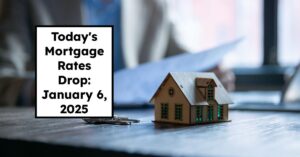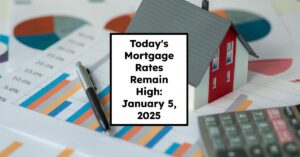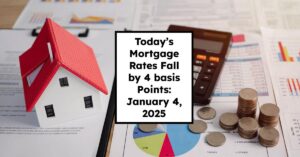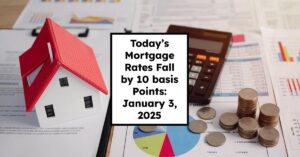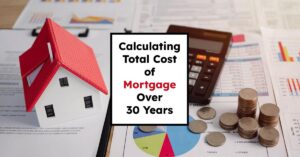Mortgage rates have climbed to near 7%, perplexing many homebuyers and market observers, especially after recent Federal Reserve rate cuts. You'd think that after the Federal Reserve (the Fed) lowered interest rates, mortgages would get cheaper, but that's not what's happening.
It's not as simple as the Fed changing rates and everything else falling into place. There's a whole bunch of stuff going on behind the scenes. It's like a complicated game with lots of players, including investors and the whole economy. Different things like how people are feeling about the economy and how investors are acting are all pushing mortgage rates up.
Basically, it’s a messy situation. If you're thinking about buying a house, or you’re just trying to understand the housing market, it’s good to know why these rates are going up even though the Fed is trying to make borrowing money easier. It's not as straightforward as it seems.
Why Are Mortgage Rates Rising Again to 7% After Fed Rate Cuts?
Key Takeaways:
- The current 30-year fixed mortgage rate stands at 7.01%.
- Federal Reserve rate cuts do not directly influence mortgage rates in the same way they affect short-term loans.
- Rising 10-year Treasury yields, driven by inflation concerns, significantly impact mortgage rates.
- Predictions for 2025 indicate mortgage rates will likely stay above 6%, making financing less accessible.
Homeownership is a pivotal goal for many people; however, the rising mortgage rates, hovering at around 7%, create challenges for buyers. As of January 1, 2025, the national average for a 30-year fixed mortgage is reported at 7.01%, a slight uptick from late December 2024 (Bankrate). This article explores the reasons behind this increase and what the future holds for borrowers.
1. The Federal Reserve’s Influence
Short-Term vs. Long-Term Rates
The Federal Reserve's influence primarily affects short-term borrowing, manipulating interest rates through its federal funds rate. However, mortgage rates are more closely linked to long-term bond yields like the 10-year Treasury yield, which reflect market expectations of future economic conditions.
- Bond Market Behavior: The Fed’s recent cuts aimed to stimulate economic activities; still, mortgage rates remained unchanged due to speculative forecasts about inflation and government spending.
- Quantitative Tightening: In addition, efforts by the Fed to reduce its balance sheet and sell off mortgage-backed securities negatively impact the demand for these assets, pushing mortgage yields higher.
2. Economic Conditions and Inflation
Resilience of the U.S. Economy
Despite the Fed’s attempts to stabilize the economy through rate cuts, robust economic growth has raised inflation concerns, contributing to sustained mortgage rates.
- Strong Economic Indicators: The job market remains strong with low unemployment rates, driving consumer spending and economic activity. For homeowners, this translates to increased demand for housing, putting upward pressure on prices and mortgage rates.
- Inflationary Pressures: Recent data shows inflation continuing to exceed the Fed's 2% target. Persistent inflationary pressures not only raise costs across sectors but also keep investment yields elevated, impacting borrowing costs.
3. Government Spending and Debt
Fiscal Policies Impacting Rates
The increasing U.S. budget deficit due to evolving fiscal policies is also a factor.
- Rising Debt Levels: To finance the budget deficit, the government regularly issues Treasury bonds. Higher levels of debt can lead to lower bond prices, which consequently push yields—and mortgage rates—higher.
- Potential Tariff Increases: The incoming administration’s proposals for higher tariffs on imported goods will likely fuel inflation, further complicating the outlook for mortgage rates (NPR).
4. Market Reactions to Fed Policy
Expectations of Future Rate Cuts
Market expectations significantly affect mortgage rates. While the Fed may cut rates further, these adjustments could be minimal relative to actual impacts on mortgage costs.
- Speculation Around Rate Moves: Market participants are beginning to foresee fewer or smaller rate cuts from the Fed in 2025 based on economic indicators, which keeps long-term rates high.
- Global Influences: International economic conditions also play a role. If foreign markets raise interest rates, it can compel U.S. investors to seek higher returns, thus increasing mortgage rates domestically.
5. Impacts on Homebuyers and the Housing Market
The implications of rising mortgage rates are significant for the housing market.
Affordability Challenges
As mortgage interest rates continue to rise, the affordability for first-time homebuyers diminishes dramatically.
| Loan Amount | Interest Rate (%) | Monthly Payment |
|---|---|---|
| $300,000 | 7.01 | $1,996 |
| $300,000 | 6.01 | $1,805 |
| $300,000 | 5.01 | $1,610 |
(This table illustrates how increasing interest rates heighten monthly mortgage payments.)
- Increasing Monthly Payments: With the average monthly payment for a $300,000 mortgage now over $1,996, potential buyers find it harder to commit, leading to a slowdown in the housing market.
Market Activity Reduction
The reaction of the housing market to rising rates has been pronounced:
- Lower Sales Volume: Increased mortgage costs lead to fewer homes sold and might deter potential sellers who fear they won't secure a better rate than they currently have.
- Tight Inventory: Existing homeowners with lower locked rates tend to stay in their homes longer, resulting in a tight real estate inventory which keeps prices elevated.
6. Investor Behavior and Capital Flows
In an interconnected global economy, mortgage rates are also influenced by investor sentiments and international capital movements.
Foreign Investments and U.S. Treasuries
The demand for U.S. Treasuries impacts mortgage rates significantly. With global uncertainties, a lack of confidence can lead to lower investments, thus raising domestic rates.
- Shifts in Investment Strategy: Should investors shift their capital to pursue higher yields elsewhere, it will lead to decreased demand for U.S. bonds, driving yields and mortgage rates higher.
7. What to Expect in 2025
Looking ahead, the outlook for mortgage rates in 2025 remains challenging:
- Current Predictions: While the Fed is expected to cut rates further, these cuts will likely not lead to a significant drop in mortgage rates for buyers. Leading institutions forecast the following average rates for 30-year fixed mortgages in 2025:
- Mortgage Bankers Association: Projects rates in the range of 6.4% to 6.6%.
- Realtor.com: Anticipates rates ending the year at around 6.2%.
- Fannie Mae: Expects rates to average 6.4%.
- Wells Fargo: Projects a slight decline with an average of 6.3%.
- Goldman Sachs: Predicts that rates will remain above 6% throughout 2025.
Recommended Read:
Mortgage Rate Predictions January 2025: Forecast for Homebuyers
Summary: A Complex Environment
The rise in mortgage rates to 7% after Fed rate cuts illustrates the intricacies of the financial landscape where economic fundamentals and market behaviors intertwine. As buyers navigate these complexities, understanding the underlying factors influencing mortgage costs becomes essential. The distant hope for lower rates in 2025 comes with the reality that economic conditions may force buyers to adjust their expectations about home financing and what they can afford.
Work with Norada in 2025, Your Trusted Source for
Turnkey Investment Properties
Discover high-quality, ready-to-rent properties designed to deliver consistent returns.
Contact us today to expand your real estate portfolio with confidence.
Contact our investment counselors (No Obligation):
(800) 611-3060
Recommended Read:
- NAR Predicts 6% Mortgage Rates in 2025 Will Boost Housing Market
- Mortgage Rates Predictions for 2025: Expert Forecast
- Half of Recent Home Buyers Got Mortgage Rates Below 5%
- Mortgage Rates Need to Drop by 2% Before Buying Spree Begins
- Will Mortgage Rates Ever Be 3% Again: Future Outlook
- Mortgage Rates Predictions for Next 2 Years
- Mortgage Rate Predictions for Next 5 Years
- Mortgage Rate Predictions for 2025: Expert Forecast
- Prediction: Interest Rates Falling Below 6% Will Explode the Housing Market
- Mortgage Rate Predictions: Why 2% and 3% Rates are Out of Reach
- How Lower Mortgage Rates Can Save You Thousands?
- How to Get a Low Mortgage Interest Rate?
- Will Mortgage Rates Ever Be 4% Again?

